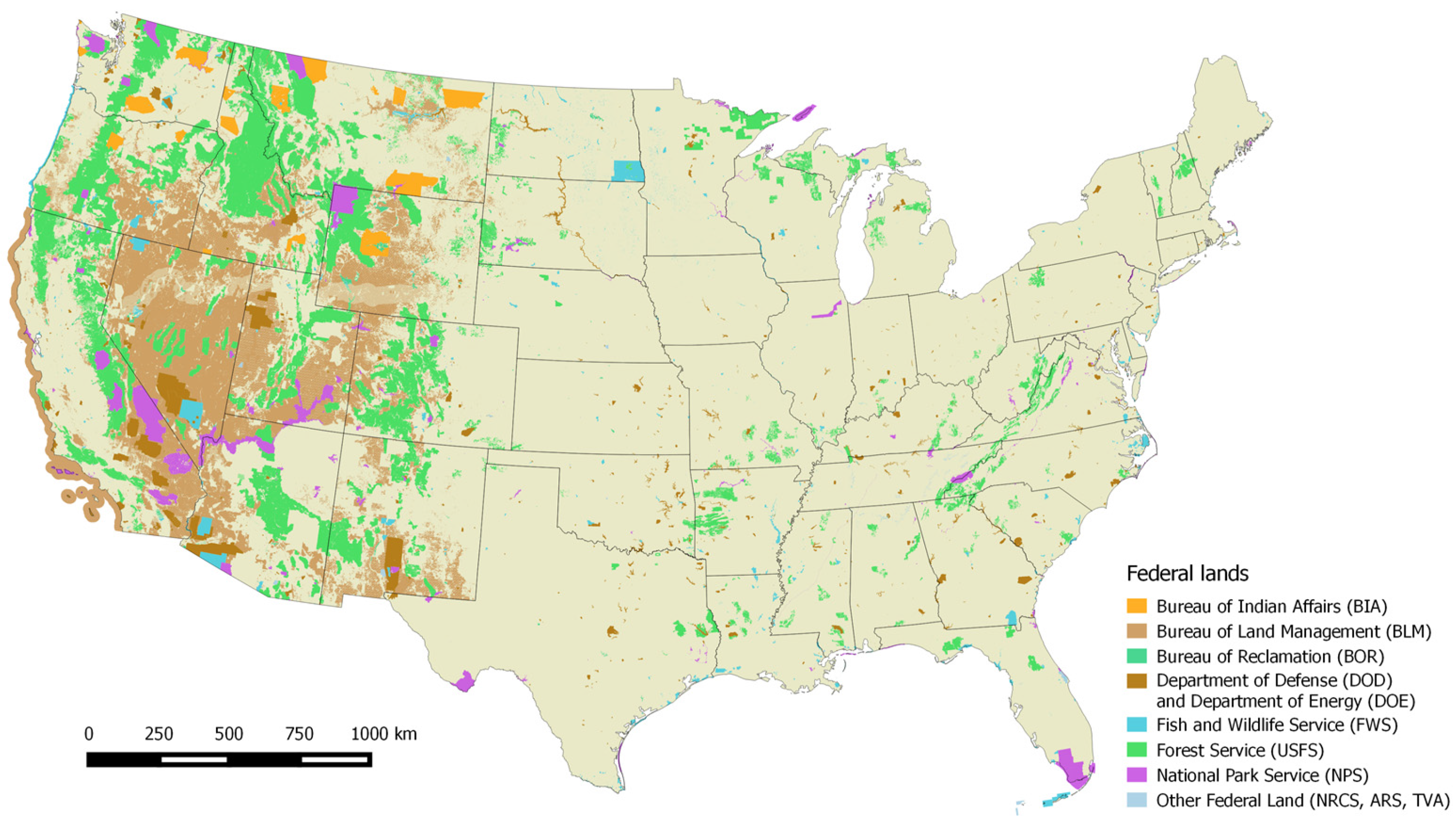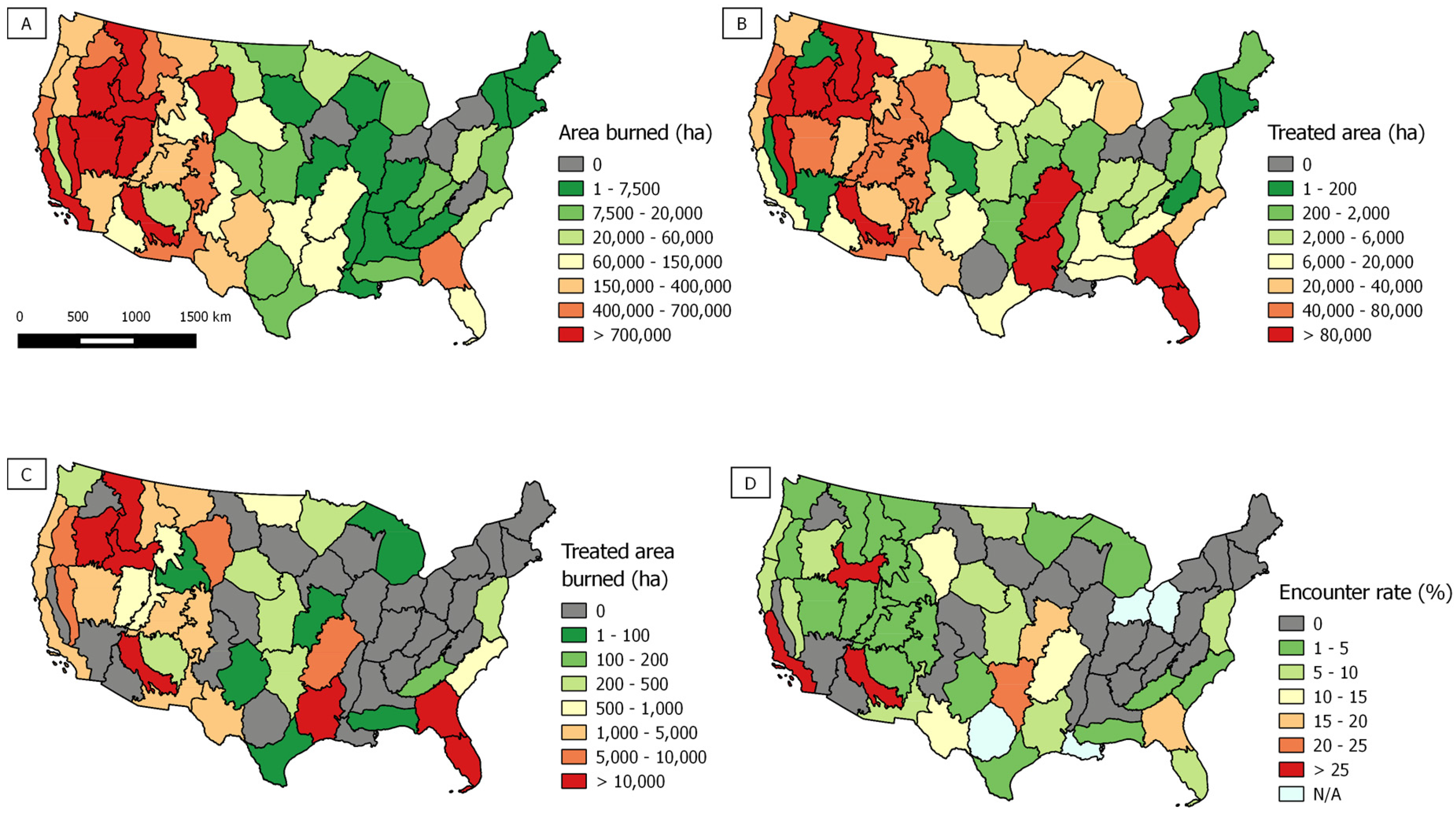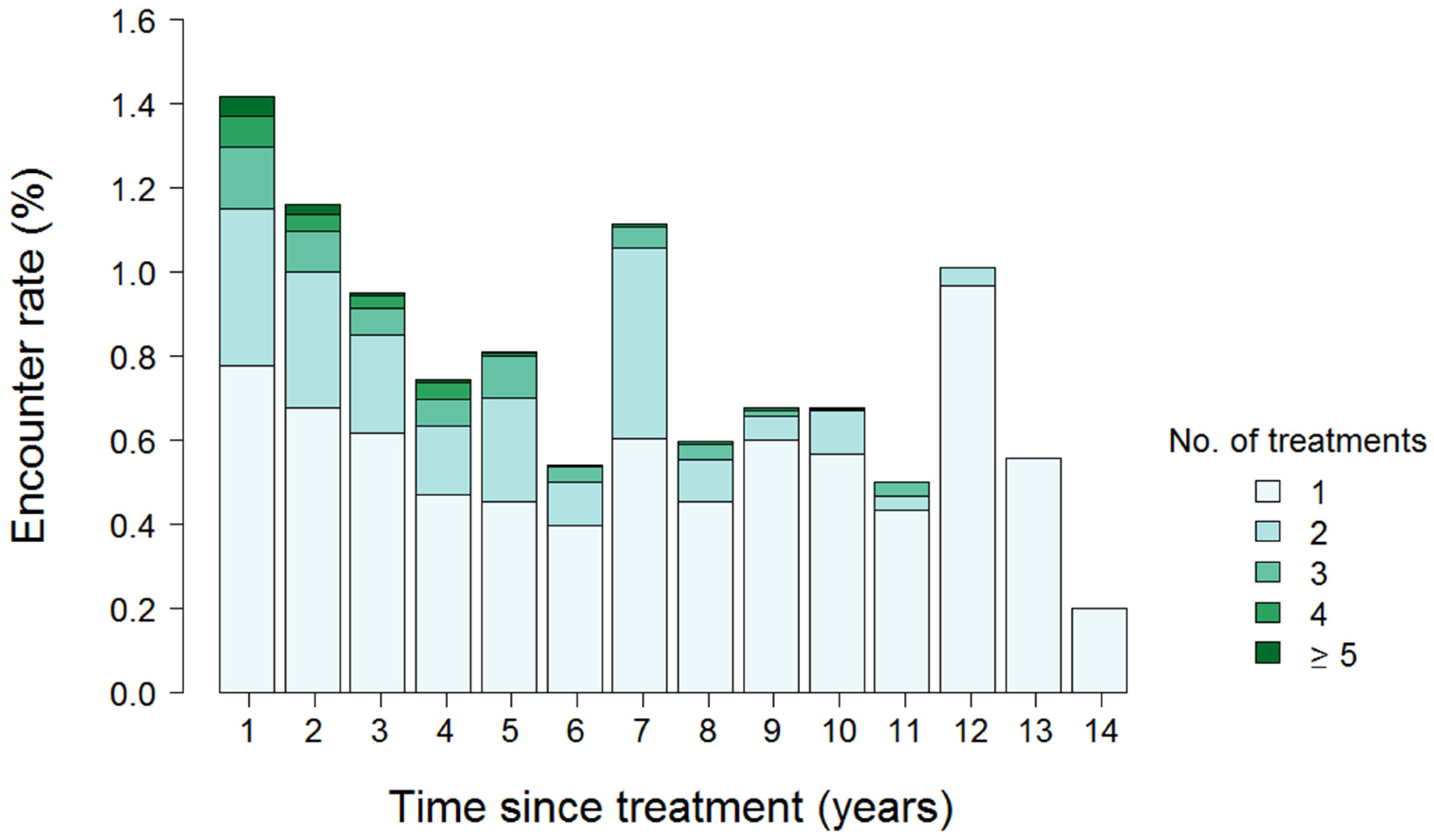Beyond Fuel Treatment Effectiveness: Characterizing Interactions between Fire and Treatments in the US
Abstract
:1. Introduction
2. Materials and Methods
2.1. Study Area
2.2. Data Background
2.3. Assessing Fuel Treatment Regimes
2.4. Deriving Encounter Rates
3. Results
4. Discussion
5. Conclusions
Supplementary Materials
Acknowledgments
Author Contributions
Conflicts of Interest
References
- Stephens, S.L.; Ruth, L.W. Federal forest-fire policy in the United States. Ecol. Appl. 2005, 15, 532–542. [Google Scholar] [CrossRef]
- Agee, J.K.; Skinner, C.N. Basic principles of forest fuel reduction treatments. For. Ecol. Manag. 2005, 211, 83–96. [Google Scholar] [CrossRef]
- Schoennagel, T.; Nelson, C.R. Restoration relevance of recent National Fire Plan treatments in forests of the western United States. Front. Ecol. Environ. 2011, 9, 271–277. [Google Scholar] [CrossRef]
- Finney, M.A. Design of regular landscape fuel treatment patterns for modifying fire growth and behavior. For. Sci. 2001, 47, 219–228. [Google Scholar]
- Stephens, S.L.; Moghaddas, J.J. Experimental fuel treatment impacts on forest structure, potential fire behavior, and predicted tree mortality in a California mixed conifer forest. For. Ecol. Manag. 2005, 215, 21–36. [Google Scholar] [CrossRef]
- Safford, H.D.; Schmidt, D.A.; Carlson, C.H. Effects of fuel treatments on fire severity in an area of wildland-urban interface, Angora Fire, Lake Tahoe Basin, California. For. Ecol. Manag. 2009, 5, 773–787. [Google Scholar] [CrossRef]
- Pritchard, S.J.; Kennedy, M.C. Fuel treatment and landform modify landscape patterns of burn severity in an extreme fire event. Ecol. Appl. 2014, 24, 571–590. [Google Scholar] [CrossRef]
- Stevens, J.T.; Safford, H.D.; Latimer, A.M. Wildfire-contingent effects of fuel treatments can promote ecological resilience in seasonally dry conifer forests. Can. J. For. Res. 2014, 44, 843–854. [Google Scholar] [CrossRef]
- Hood, S.M.; Baker, S.; Sala, A. Fortifying the forest: Thinning and burning increase resistance to bark beetle outbreak and promote forest resiliency. Ecol. Appl. 2016, in press. [Google Scholar] [CrossRef]
- Kalies, E.L.; Yocom Kent, L.L. Tamm Review: Are fuel treatments effective at achieving ecological and social objectives? A systematic review. For. Ecol. Manag. 2016, 375, 84–95. [Google Scholar] [CrossRef]
- Finney, M.A.; Seli, R.C.; McHugh, C.W.; Ager, A.A.; Bahro, B.; Agee, J.K. Simulation of long-term landscape-level fuel treatment effects on large fires. Int. J. Wildland Fire 2008, 16, 712–717. [Google Scholar] [CrossRef]
- Ager, A.A.; Vaillant, N.M.; Finney, M.A. A comparison of landscape fuel treatment strategies to mitigate wildland fire risk in the urban interface and preserve old growth structure. For. Ecol. Manag. 2010, 259, 1556–1570. [Google Scholar] [CrossRef]
- Rhodes, J.J.; Odion, D.C. Evaluation of the efficacy of forest manipulations still needed. BioScience 2004, 54, 980. [Google Scholar] [CrossRef]
- Rhodes, J.J.; Baker, W.L. Fire probability, fuel treatment effectiveness and ecological tradeoffs in western U.S. public forests. Open For. Sci. J. 2008, 1, 1–7. [Google Scholar]
- Campbell, J.L.; Harmon, M.E.; Mitchell, S.R. Can fuel-reduction treatments really increase forest carbon storage in the western US by reducing future fire emissions? Front. Ecol. Environ. 2011, 10, 83–90. [Google Scholar] [CrossRef]
- North, M.; Brough, A.; Long, J.; Collins, B.; Bowden, P.; Yasuda, D.; Miller, J.; Sugihara, N. Constraints on mechanized treatment significantly limit mechanical fuels reduction extent in the Sierra Nevada. J. For. 2015, 113, 40–48. [Google Scholar] [CrossRef]
- North, M.P.; Collins, B.M.; Stephens, S.L. Using fire to increase the scale, benefits and future maintenance of fuels treatments. J. For. 2012, 110, 392–401. [Google Scholar] [CrossRef]
- Hessburg, P.F.; Churchill, D.J.; Larson, A.J.; Haugo, R.D.; Miller, C.; Spies, T.A.; North, M.P.; Povak, N.A.; Belote, R.T.; Singleton, P.H.; et al. Restoring fire-prone Inland Pacific landscapes: Seven core principles. Landsc. Ecol. 2015, 30, 1805–1835. [Google Scholar] [CrossRef]
- Doane, D.L.; O’Laughlin, J.; Morgan, P.; Miller, C. Barriers to wildland fire use: A preliminary problem analysis. Int. J. Wilderness 2006, 12, 36–38. [Google Scholar]
- Black, A.; Williamson, M.; Doane, D. Wildland fire use barriers and facilitators. Fire Manag. Today 2008, 68, 10–14. [Google Scholar]
- Reinhardt, E.D.; Keane, R.E.; Calkin, D.E.; Cohen, J.D. Objectives and considerations for wildland fuel treatment in forested ecosystems of the interior western United States. For. Ecol. Manag. 2008, 256, 1997–2006. [Google Scholar] [CrossRef]
- Parks, S.A.; Holsinger, L.M.; Miller, C.; Nelson, C.R. Wildland fire as a self-regulating mechanism: The role of previous burns and fire in limited fire progression. Ecol. Appl. 2015, 25, 1478–1492. [Google Scholar] [CrossRef] [PubMed]
- Moghaddas, J.J; Craggs, L. A fuel treatment reduces fire severity and increases suppression efficiency in a mixed conifer forest. Int. J. Wildland Fire 2008, 16, 673–678. [Google Scholar] [CrossRef]
- The National Strategy: The Final Phase in the Development of the National Cohesive Wildland Fire Management Strategy. Available online: https://www.forestsandrangelands.gov/strategy/documents/strategy/CSPhaseIIINationalStrategyApr2014.pdf (accessed on 27 July 2016).
- Calkin, D.E.; Thompson, M.P.; Finney, M.A. Negative consequences of positive feedbacks in US wildfire management. For. Ecosyst. 2015, 2, 9. [Google Scholar] [CrossRef]
- Parks, S.A.; Miller, C.; Nelson, C.R.; Holden, Z.A. Previous fires moderate burn severity of subsequent wildland fires in two large western US wilderness areas. Ecosystems 2014, 17, 29–42. [Google Scholar] [CrossRef]
- Parks, S.A.; Parisien, M.A.; Miller, C. Multi-scale evaluation of the environmental controls on burn probability in a southern Sierra Nevada landscape. Int. J. Wildland Fire. 2011, 20, 815–828. [Google Scholar] [CrossRef]
- Parisien, M.A.; Snetsinger, S.; Greenberg, J.A.; Nelson, C.R.; Schoennagel, T.; Dobrowski, S.Z.; Moritz, M.A. Spatial variability in wildfire probability across the western United States. Int. J. Wildland Fire 2012, 21, 313–327. [Google Scholar] [CrossRef]
- Eidenshink, J.C.; Schwind, B.; Brewer, K.; Zhu, Z.L.; Quayle, B.; Howard, S.M. A project for monitoring trends in burn severity. Fire Ecol. 2007, 3, 3–21. [Google Scholar] [CrossRef]
- Rollins, M.G. LANDFIRE: A nationally consistent vegetation, wildland fire, and fuel assessment. Int. J. Wildland Fire 2009, 18, 235–249. [Google Scholar] [CrossRef]
- Schoennagel, T.; Nelson, C.R.; Theobald, D.M.; Carnwath, G.C.; Chapman, T.B. Implementation of National Fire Plan treatments near the wildland-urban interface in the western United States. Proc. Natl. Acad. Sci. USA 2009, 106, 10706–10711. [Google Scholar] [CrossRef] [PubMed]
- Gergely, K.J.; McKerrow, A. PAD-US—National Inventory of Protected Areas: U.S. Geological Survey Fact Sheet 2013–3086. Available online: http://pubs.usgs.gov/fs/2013/3086/pdf/fs20133086.pdf (accessed on 11 October 2016).
- Theobald, D.M.; Romme, W.H. Expansion of the US wildland-urban interface. Landsc. Urban Plan. 2007, 83, 340–354. [Google Scholar] [CrossRef]
- Aplet, G.H.; Wilmer, B. The wildland fire challenge: Protecting communities and restoring ecosystems. George Wright Forum 2005, 22, 32–44. [Google Scholar]
- Radeloff, V.C.; Hammer, R.B.; Stewart, S.I.; Fried, J.S.; Holcomb, S.S.; McKeefry, J.F. The wildland-urban interface in the United States. Ecol. Appl. 2005, 15, 799–805. [Google Scholar] [CrossRef]
- USDA & USDI. Urban Wildland Interface Communities within Vicinity of Federal Lands That Are at High Risk from Wildlife; Federal Register: Washington, DC, USA, 2001; Volume 66, pp. 751–777.
- Kolden, C.A.; Lutz, J.A.; Key, C.H.; Kane, J.T.; van Wagtendonk, J.W. Mapped versus actual burned area within wildfire perimeters: Characterizing the unburned. For. Ecol. Manag. 2012, 286, 38–47. [Google Scholar] [CrossRef]
- Miller, J.D.; Safford, H. Trends in wildfire severity: 1984–2010 in the Sierra Nevada, Modoc Plateau, and Southern Cascades, California, USA. Fire Ecol. 2012, 8, 41–57. [Google Scholar] [CrossRef]
- Riley, K.L.; Abatzoglou, J.T.; Grenfell, I.C.; Klene, A.E.; Heinsch, F.A. The relationship of large fire occurrence with drought and fire danger indices in the western USA, 1984–2008: The role of temporal scale. Int. J. Wildland Fire. 2013, 22, 894–909. [Google Scholar] [CrossRef]
- Parks, S.A.; Parisien, M.A.; Miller, C.; Dobrowski, S.Z. Fire activity and severity in the western US vary along proxy gradients representing fuel amount and fuel moisture. PLoS ONE 2014, 9, e99699. [Google Scholar] [CrossRef] [PubMed]
- The Nature Conservancy. Terrestrial Ecoregions. Available online: map.tnc.org/gis_data.html (accessed on 11 October 2016).
- Bailey, R.G. Descriptions of the Ecoregions of the United States, 2nd ed.USDA Forest Service: Washington, DC, USA, 1995.
- Price, O.F.; Bradstock, R.A. The effect of fuel age on the spread of fire in sclerophyll forest in the Sydney region of Australia. Int. J. Wildland Fire. 2010, 19, 35–45. [Google Scholar] [CrossRef]
- Safford, H.D.; Stevens, J.T.; Merriam, K.; Meyer, M.D.; Latimer, A.M. Fuel treatment effectiveness in California yellow pine and mixed conifer forests. For. Ecol. Manag. 2012, 274, 17–28. [Google Scholar] [CrossRef]
- Kennedy, M.C.; Johnson, M.C. Fuel treatment prescriptions alter spatial patterns of fire severity around the wildland-urban interface during the Wallow Fire, Arizona, USA. For. Ecol. Manag. 2014, 318, 122–132. [Google Scholar] [CrossRef]
- Collins, B.M.; Stephens, S.L.; Moghaddas, J.J.; Battles, J. Challenges and approaches in planning fuel treatments across fire-excluded forested landscapes. J. For. 2010, 108, 24–31. [Google Scholar]
- Stephens, S.L. Forest fire causes and extent on United States Forest Service lands. Int. J. Wildland Fire 2005, 14, 213–222. [Google Scholar] [CrossRef]
- Stephens, S.L.; Collins, B.M.; Roller, G. Fuel treatment longevity in a Sierra Nevada mixed conifer forest. For. Ecol. Manag. 2012, 285, 204–212. [Google Scholar] [CrossRef]
- Martinson, E.J.; Omi, P.N. Fuel Treatments and Fire Severity: A Meta-Analysis; USDA Forest Service: Fort Collins, CO, USA, 2013.
- Ager, A.A.; Vaillant, N.M.; McMahan, A. Restoration of fire in managed forests: A model to prioritize landscapes and analyze tradeoffs. Ecosphere 2013, 4, 1–19. [Google Scholar] [CrossRef]
- Thompson, M.P.; Bowden, P.; Brough, A.; Scott, J.H.; Gilbertson-Day, J.; Taylor, A.; Anderson, J.; Haas, J.R. Application of wildfire risk assessment results to wildfire response planning in the southern Sierra Nevada, California, USA. Forests 2016, 7, 64. [Google Scholar] [CrossRef]
- Barnett, K.; Miller, C.; Venn, T.J. Using risk analysis to reveal opportunities for the management of unplanned ignitions in wilderness. J. For. 2016, in press. [Google Scholar]
- Krawchuk, M.A.; Moritz, M.A.; Parisien, M.A.; Van Dorn, J.; Hayhoe, K. Global pyrogeography: The current and future distribution of wildfire. PLoS ONE 2009, 4, e5102. [Google Scholar] [CrossRef] [PubMed]
- Littell, J.S.; Oneil, E.E.; McKenzie, D.; Hicke, J.A.; Lutz, J.A.; Norheim, R.A.; Elsner, M.M. Forest ecosystems, disturbance, and climatic change in Washington State, USA. Clim. Chang. 2010, 102, 129–158. [Google Scholar] [CrossRef]
- Sparks, A.M.; Boschetti, L.; Smith, A.M.S.; Tinkham, W.T.; Lannom, K.O.; Newingham, B.A. An accuracy assessment of the MTBS burned area product for shrub-steppe fires in the northern Great Basin, United States. Int. J. Wildland Fire 2015, 24, 70–78. [Google Scholar] [CrossRef]
- Finney, M.A.; McHugh, C.W.; Grenfell, I.C. Stand- and landscape-level effects of prescribed burning on two Arizona wildfires. Can. J. For. Res. 2005, 35, 1714–1722. [Google Scholar] [CrossRef]




| Treatment Type | Description |
|---|---|
| Clearcut | The cutting of essentially all trees, producing a fully exposed microclimate for the development of a new age class |
| Harvest | A general term for the cutting, felling, and gathering of forest timber. The term harvest was assigned to events where there was not enough information available to call them one of the two distinct types, clearcut or thinning |
| Mastication | Means by which vegetation is mechanically “mowed“ or “chipped“ into small pieces and changed from a vertical to a horizontal arrangement |
| Other mechanical | Catch all term for a variety of forest and rangeland mechanical activities related to fuels reduction and site preparation including: piling of fuels, chaining, lop and scatter, thinning of fuels, Dixies harrow, etc. |
| Prescribed fire | Any fire ignited by management actions to meet specific objectives. A written, approved prescribed fire plan must exist, and NEPA requirements (where applicable) must be met prior to ignition. |
| Thinning | A tree removal practice that reduces tree density and competition between trees in a stand. Thinning concentrates growth on fewer, high-quality trees, provides periodic income, and generally enhances tree vigor |
| Treatment Unit Type | Number of Treatment Units | Total Treatment Unit Area | Mean Treatment Unit Size (25th, 75th Percentiles) |
|---|---|---|---|
| Clearcut | 2847 | 29,729 | 10.44 (1.94, 12.47) |
| Harvest | 7929 | 92,432 | 11.66 (1.50, 13.59) |
| Mastication | 2209 | 38,465 | 17.41 (0.49, 14.73) |
| Other mechanical | 29,173 | 473,957 | 16.25 (0.40, 9.50) |
| Prescribed fire | 47,261 | 1,631,087 | 34.51 (0.29, 11.20) |
| Thin-and-burn | 9397 | 107,311 | 11.42 (0.72, 12.36) |
| Thinning | 37,667 | 431,869 | 11.47 (1.74, 13.13) |
| Treatment Unit Size Class (ha) | Number of Treatments | Area Treated (ha) | Treated Area Burned (ha) | Encounter Rate (%) |
|---|---|---|---|---|
| 0–5 | 74,966 | 99,547 | 6331 | 6.8 |
| 5–10 | 21,809 | 158,899 | 9718 | 6.5 |
| 10–25 | 24,156 | 374,289 | 21,107 | 6.2 |
| 25–50 | 8125 | 281,081 | 15,543 | 6.8 |
| 50–100 | 3755 | 259,466 | 13,981 | 7.2 |
| 100–200 | 1753 | 244,308 | 11,783 | 8.1 |
| 200–500 | 1122 | 352,008 | 23,844 | 10.9 |
| 500–1000 | 503 | 352,731 | 23,907 | 15.5 |
| 1000–5000 | 276 | 498,034 | 61,382 | 21.4 |
| >5000 | 18 | 184,486 | 28,690 | 50.0 |
| Number of Times Treated | Number of Treatments | Area Treated (ha) | Treated Area Burned (ha) | Encounter Rate (%) |
|---|---|---|---|---|
| 1 | 85,337 | 2,178,223 | 152,405 | 5.2 |
| 2 | 32,955 | 461,365 | 42,889 | 7.9 |
| 3 | 12,143 | 126,897 | 17,985 | 11.3 |
| 4 | 3992 | 25,021 | 2206 | 13.3 |
| ≥5 | 2056 | 13,344 | 802 | 15.7 |
© 2016 by the authors; licensee MDPI, Basel, Switzerland. This article is an open access article distributed under the terms and conditions of the Creative Commons Attribution (CC-BY) license (http://creativecommons.org/licenses/by/4.0/).
Share and Cite
Barnett, K.; Parks, S.A.; Miller, C.; Naughton, H.T. Beyond Fuel Treatment Effectiveness: Characterizing Interactions between Fire and Treatments in the US. Forests 2016, 7, 237. https://doi.org/10.3390/f7100237
Barnett K, Parks SA, Miller C, Naughton HT. Beyond Fuel Treatment Effectiveness: Characterizing Interactions between Fire and Treatments in the US. Forests. 2016; 7(10):237. https://doi.org/10.3390/f7100237
Chicago/Turabian StyleBarnett, Kevin, Sean A. Parks, Carol Miller, and Helen T. Naughton. 2016. "Beyond Fuel Treatment Effectiveness: Characterizing Interactions between Fire and Treatments in the US" Forests 7, no. 10: 237. https://doi.org/10.3390/f7100237
APA StyleBarnett, K., Parks, S. A., Miller, C., & Naughton, H. T. (2016). Beyond Fuel Treatment Effectiveness: Characterizing Interactions between Fire and Treatments in the US. Forests, 7(10), 237. https://doi.org/10.3390/f7100237






